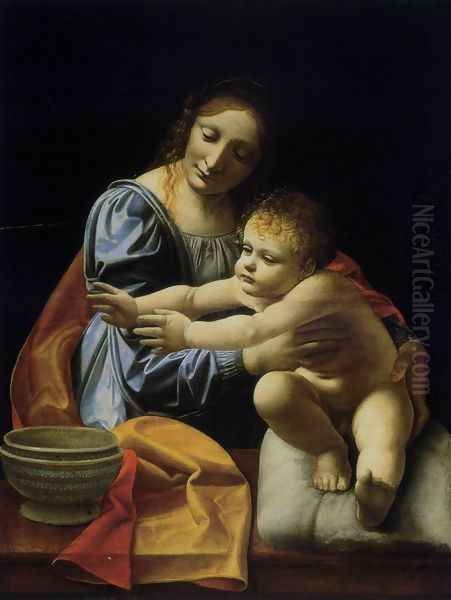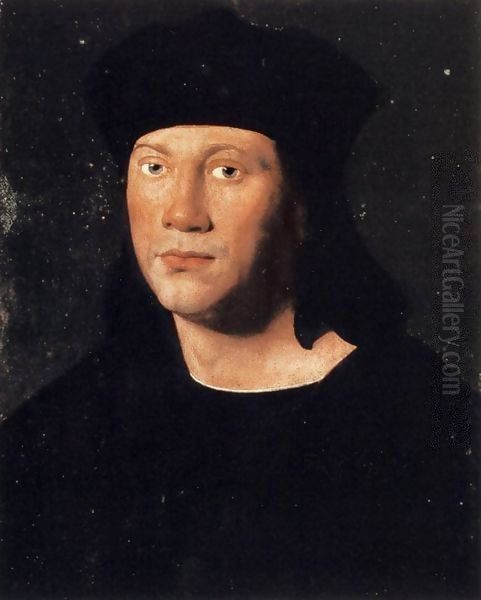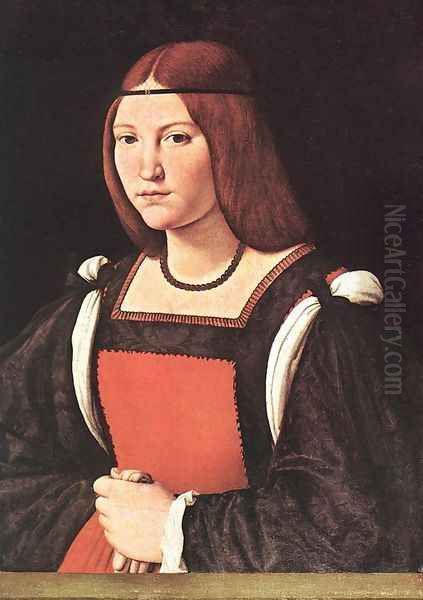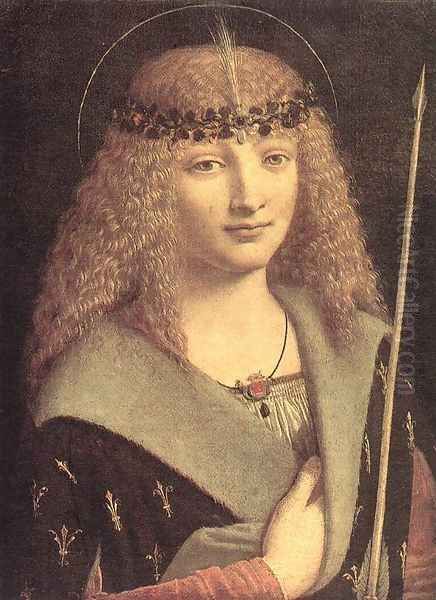Giovanni Antonio Boltraffio (circa 1467/1468 – 1516) stands as a significant, if sometimes overshadowed, figure in the constellation of artists who illuminated the Italian High Renaissance. A nobleman by birth and a painter by vocation, Boltraffio’s artistic journey is inextricably linked with the towering genius of Leonardo da Vinci. As one of Leonardo's most gifted pupils and closest associates in Milan, he absorbed the master's revolutionary techniques and intellectual approach to art, yet managed to forge a distinct artistic personality. His oeuvre, though not vast, is characterized by a refined elegance, psychological depth in portraiture, and a subtle, melancholic beauty that continues to captivate viewers centuries later. This exploration delves into his life, his profound connection with Leonardo, his artistic style, his key works, and his enduring place in the annals of art history.
Early Life and Noble Milanese Roots
Giovanni Antonio Boltraffio was born in Milan around 1467 or 1468 into an aristocratic family. This privileged background likely afforded him a comprehensive education, which would have included exposure to the humanist currents sweeping through Italy at the time. Unlike many of his contemporaries who came from artisanal backgrounds, Boltraffio's entry into the world of painting was a choice perhaps driven more by passion and intellectual curiosity than by economic necessity. His noble status might also explain the relatively small number of documented works, as he may not have been reliant on continuous commissions for his livelihood in the same way as a professional craftsman-painter.
Milan, under the rule of the Sforza dukes, particularly Ludovico Sforza "il Moro," was a vibrant cultural center, attracting talent from across Italy. It was into this stimulating environment that Boltraffio came of age. The city was a hub of artistic innovation, and the arrival of Leonardo da Vinci in the early 1480s would prove to be a transformative event for Milanese art and, crucially, for Boltraffio himself.
The Pivotal Apprenticeship with Leonardo da Vinci

The most defining period of Boltraffio’s artistic formation began in 1491 when he entered the workshop of Leonardo da Vinci. Leonardo, already a celebrated artist, had established a bustling studio in Milan, attracting a coterie of talented young painters eager to learn from him. Boltraffio quickly distinguished himself, becoming not just a pupil but also an assistant and a close associate of the master. Leonardo himself mentions a "Gian Antonio" in his notebooks, a reference widely accepted to be Boltraffio, indicating a personal connection.
Life in Leonardo's studio was an immersive experience. It was less a formal academy and more a collaborative environment where students learned through direct observation, practice, and participation in the master's projects. Leonardo's approach was revolutionary; he emphasized the scientific study of nature, anatomy, light, and shadow (chiaroscuro), and the subtle rendering of human emotion. Boltraffio would have been privy to Leonardo's experiments with oil paints, his meticulous preparatory drawings, and his philosophical musings on art. He worked alongside other notable pupils such as Andrea Salai, a long-term companion of Leonardo, and Marco d'Oggiono, with whom Boltraffio would later collaborate. Francesco Melzi, another devoted follower who would become Leonardo's heir, joined the studio somewhat later.
The influence of Leonardo on Boltraffio was profound and multifaceted. It is evident in the sfumato (smoky, soft-edged modeling) that often characterizes his figures, the enigmatic smiles reminiscent of Leonardo's own, and the psychological intensity he brought to his portraits. However, Boltraffio was not a mere imitator. He assimilated Leonardo's lessons and filtered them through his own aristocratic sensibility, resulting in a style that was both Leonardesque and uniquely his own.
Emergence of an Independent Style: Blending Grace and Melancholy
While deeply indebted to Leonardo, Boltraffio developed an artistic language that possessed its own distinct characteristics. His figures often exhibit a refined, almost ethereal beauty, imbued with a sense of gentle melancholy or quiet introspection. His handling of paint could be exceptionally delicate, with smooth, porcelain-like skin tones and meticulously rendered details, particularly in hair and fabrics.
Compared to Leonardo's pervasive sfumato, which often dissolves forms into atmosphere, Boltraffio's contours could be more defined, his modeling sometimes crisper, lending his figures a sculptural solidity. His color palettes, while often subtle and harmonious, could also incorporate richer, more vibrant hues than typically seen in Leonardo's Milanese period works. There's a certain aristocratic poise and reserve in his subjects, reflecting perhaps his own social standing. He excelled in capturing a sense of inner life, a psychological presence that draws the viewer in. This ability to convey nuanced emotion, undoubtedly honed under Leonardo's tutelage, became a hallmark of his portraiture.

His contemporaries in the Lombard school, such as Bernardino Luini or Andrea Solario, also responded to Leonardo's influence, each in their own way. Luini, for instance, adopted a sweeter, more readily accessible version of Leonardo's style, while Solario combined Leonardesque softness with a Venetian richness of color and a Northern European precision. Boltraffio's path was one of sophisticated refinement and psychological depth.
Masterpieces of Religious Devotion
Boltraffio’s contributions to religious art are significant, showcasing his ability to imbue sacred themes with emotional resonance and technical finesse. One of his earliest documented major works is the altarpiece depicting the Resurrection of Christ, with Saints Leonard and Lucy. This piece was commissioned for the Grifi Chapel in the church of San Giovanni sul Muro in Milan, though some sources mention it for San Domenico. It was a collaborative effort with his fellow Leonardesque, Marco d'Oggiono, around 1491-1494. Today, this impressive work is housed in the Gemäldegalerie, Berlin. The composition reveals the influence of Leonardo in the pyramidal structure and the expressive figures, while the individual contributions of Boltraffio and d'Oggiono can be discerned by art historians, with Boltraffio often credited with the more refined and psychologically nuanced figures.
Perhaps his most celebrated religious painting is the Madonna and Child, also known as the Casio Altarpiece or Pala Casio, painted around 1500 for the Casio family chapel in the Church of Santa Maria della Misericordia in Bologna. Now a prized possession of the Musée du Louvre in Paris, this work depicts the Virgin Mary tenderly gazing at the Christ Child, who looks out towards the viewer. They are flanked by Saint John the Baptist and Saint Sebastian, and, in a departure from more traditional sacra conversazione, two donors: the poet Girolamo Casio and his father. The figures are rendered with Boltraffio's characteristic smooth modeling and delicate features. The Virgin's expression is one of serene melancholy, a hallmark of Boltraffio's style. The inclusion of the donors, particularly the prominent poet Girolamo Casio, speaks to Boltraffio's connections and his activity in Bologna.
Another notable work is the Madonna and Child with St. John and a Donor, painted for the Church of San Paolo in Bologna. This further underscores his activity in that city. Boltraffio's religious paintings often convey a sense of quiet intimacy and profound spirituality, avoiding overt drama in favor of subtle emotional expression. His figures, even in sacred contexts, possess a very human, relatable quality.
A Gifted Portraitist: Capturing the Lombard Nobility

Boltraffio's true genius arguably shone brightest in the realm of portraiture. He possessed an uncanny ability to capture not just the likeness but also the character and inner world of his sitters. His aristocratic background may have given him a particular affinity for portraying members of his own social class, and his portraits are often imbued with an air of refined elegance and intellectual depth.
Among his most famous portraits is the Portrait of a Youth with an Arrow, housed in the Pushkin Museum, Moscow. The subject, often identified as Saint Sebastian due to the arrow, or perhaps a young nobleman in allegorical guise, is depicted with striking immediacy. The youth’s androgynous beauty, the soft modeling of the face, the intricate rendering of the curling hair, and the enigmatic expression are all hallmarks of Boltraffio's Leonardesque training, yet the overall effect is distinctly his. The delicate handling of light and shadow creates a palpable sense of volume and presence.
His connection with the Bolognese poet Girolamo Casio proved fruitful for portraiture. Boltraffio painted several likenesses of Casio, including the renowned Portrait of Girolamo Casio (Pinacoteca di Brera, Milan). In this work, Casio is presented with a laurel wreath, symbolizing his poetic achievements, and a scroll. His gaze is direct and intelligent, and Boltraffio masterfully conveys the poet's intellectual acuity and perhaps a touch of vanity. The meticulous attention to the textures of fabric and the subtle modeling of the face demonstrate Boltraffio's technical skill.
Another compelling work is the Portrait of a Lady as Saint Lucy (Thyssen-Bornemisza Museum, Madrid). The sitter, an unknown noblewoman, is depicted with the attributes of Saint Lucy (eyes on a platter), a common practice in Renaissance portraiture to associate the sitter with a virtuous saint. Her expression is serene and slightly melancholic, her features exquisitely rendered. The painting showcases Boltraffio's ability to combine idealized beauty with a sense of individual personality. Other portraits, such as the Portrait of a Man in Profile (National Gallery, London), further attest to his skill in this genre, capturing the sitter with a quiet dignity and psychological insight. These portraits are invaluable records of the Milanese and Bolognese aristocracy of the period, filtered through Boltraffio's sensitive and sophisticated artistic vision.
Travels and Patronage: Milan and Bologna

While Milan remained his primary base, Boltraffio's career saw him travel, most notably to Bologna. His connections with the Casio family were clearly important, leading to significant commissions in that city, including the aforementioned Pala Casio for Santa Maria della Misericordia and portraits of Girolamo Casio. Bologna, at this time, was a significant artistic center in its own right, with painters like Francesco Francia and Lorenzo Costa active. Boltraffio's presence there would have brought a strong current of Milanese Leonardism into the Emilian artistic scene.
These travels suggest a degree of independence and a reputation that extended beyond Milan. His ability to secure patronage from influential families like the Casio indicates that his skills were recognized and sought after. He also seems to have been involved in public life to some extent; records show him serving on a committee for the north portal of Milan Cathedral, a prestigious project that would have involved discussions with other leading artists and architects of the city, possibly including figures like Bramante, who was also active in Milan.
The interplay between Milan and Bologna in his career highlights the interconnectedness of Italian artistic centers during the Renaissance. Artists often traveled for commissions, carrying stylistic influences with them and, in turn, absorbing new ideas from the regions they visited. Boltraffio's work in Bologna is a testament to this cultural exchange.
Technical Prowess and Artistic Language
Boltraffio's technical skill was considerable. He was adept in the use of oil paints, achieving smooth, luminous surfaces and subtle gradations of tone. His drawings, though fewer survive compared to some contemporaries, demonstrate a sure hand and a keen observational ability. He was proficient in metalpoint, a demanding drawing technique favored by Leonardo, which requires precision and foresight as lines cannot be easily erased.
His use of chiaroscuro, the dramatic interplay of light and shadow, was a key element of his style, learned from Leonardo. However, as noted by some critics, his application of it could sometimes be less about atmospheric dissolution (Leonardo's sfumato) and more about creating strong, sculptural forms. His line, while often softened, could also be incisive and elegant, defining forms with clarity.
The "Allegory of Casio," another work linked to the poet, showcases his ability to engage with complex iconographical programs, a skill valued in Renaissance courtly circles. While the exact meaning of such allegories can be elusive to modern viewers, they attest to the intellectual environment in which Boltraffio operated, where art was often expected to convey sophisticated literary or philosophical ideas. His paintings are not merely beautiful objects; they are imbued with a thoughtful, often poetic, sensibility.
Contemporaries and the Lombard Milieu
Boltraffio operated within a rich artistic environment in Lombardy, profoundly shaped by Leonardo da Vinci's two decades in Milan. Besides Marco d'Oggiono and Andrea Salai, other artists who felt Leonardo's impact included Ambrogio de Predis, known for his sharply defined portraits and his association with Leonardo on the Virgin of the Rocks commission. Bernardino Luini became immensely popular for his gentle, sweet depictions of Madonnas and saints, which translated Leonardo's style into a more accessible and widely imitated idiom. Giovanni Agostino da Lodi was another Lombard painter who absorbed Leonardesque qualities.
Andrea Solario, a sophisticated and well-traveled artist, blended Leonardesque sfumato with elements from Venetian painting (perhaps from encountering the work of Antonello da Messina or Giovanni Bellini) and even Northern European precision. Bramantino (Bartolomeo Suardi), while influenced by Leonardo, developed a more austere, architectonic style. These artists, along with Boltraffio, constituted the "Leonardeschi," the followers of Leonardo who disseminated and adapted his innovations. Boltraffio stands out among them for the aristocratic refinement and psychological penetration of his best work, particularly his portraits. His style was perhaps less easily popularized than Luini's, but it possessed a unique depth and subtlety.
The Shadow of the Master: Attribution and Legacy
Working so closely with a dominant figure like Leonardo da Vinci inevitably presents challenges for art historical attribution. The collaborative nature of Renaissance workshops means that the hand of the master and his pupils can often be intertwined in a single work. Over the centuries, some of Boltraffio's paintings have been attributed to Leonardo, and vice versa.
A famous case in point, though in reverse, is the Salvator Mundi. For a time, some scholars considered Boltraffio as a possible author for versions of this composition, given his proximity to Leonardo and his skill. However, the version that sold for a record price in 2017 is now generally, though not universally, accepted as an autograph work by Leonardo himself. This highlights the complexities of distinguishing between the work of Leonardo and his most talented followers. The "Litta Madonna" (Hermitage Museum), often attributed to Leonardo, has also been suggested by some as a work by Boltraffio or another close pupil, demonstrating the ongoing debates in connoisseurship.
Despite these attributional complexities, Boltraffio's own artistic identity is clear in his securely attributed works. His legacy lies in his contribution to the Lombard school and his role in transmitting and personalizing Leonardo's artistic revolution. He was not a radical innovator on the scale of his master, but he was a painter of exceptional sensitivity and skill who created works of enduring beauty.
Later Years and Enduring Influence
Relatively little is known about Boltraffio's later years. According to his tombstone inscription in the Church of San Paolo in Compito (later demolished), he died in Milan in 1516, at the relatively young age of about 48 or 49. This was just a few years before Leonardo da Vinci himself passed away in France.
Though his career was not exceptionally long and his output not as prolific as some of his contemporaries, Boltraffio left an indelible mark. His works were admired in his lifetime and continued to be valued by collectors. Today, his paintings are found in major museums around the world, including the Louvre (Paris), the National Gallery (London), the Gemäldegalerie (Berlin), the Pinacoteca di Brera (Milan), the Pushkin Museum (Moscow), and the Thyssen-Bornemisza Museum (Madrid).
His influence can be seen in the continuing tradition of refined portraiture in Milan. While perhaps not founding a "school" in the way some artists did, his example of psychological depth and elegant execution contributed to the high standards of Lombard painting. He remains a key figure for understanding the impact of Leonardo da Vinci in Milan and the distinctive character of the Lombard Renaissance. His ability to absorb the lessons of one of history's greatest artistic minds while retaining a personal voice is a testament to his own considerable talent.
Conclusion: A Refined Interpreter of the Renaissance Ideal
Giovanni Antonio Boltraffio was more than just a follower of Leonardo da Vinci; he was a gifted artist who translated the profound innovations of his master into a uniquely personal and refined visual language. His aristocratic background, his intellectual engagement with art, and his innate sensitivity allowed him to create works, particularly portraits and intimate religious scenes, that resonate with psychological depth and a subtle, melancholic beauty.
His paintings offer a window into the sophisticated cultural milieu of Renaissance Milan and Bologna. They showcase a mastery of technique, a nuanced understanding of human emotion, and an elegant aesthetic that sets him apart. While the colossal shadow of Leonardo sometimes obscures the achievements of his pupils, Boltraffio’s contributions are significant and merit independent appreciation. He remains an important artist of the High Renaissance, a painter whose delicate touch and insightful portrayals continue to speak to us across the centuries, securing his place as a luminous, if sometimes understated, star in the rich firmament of Italian art. His work reminds us that even in the orbit of a genius, individual talents can shine brightly, reflecting and reinterpreting that brilliance in new and compelling ways.